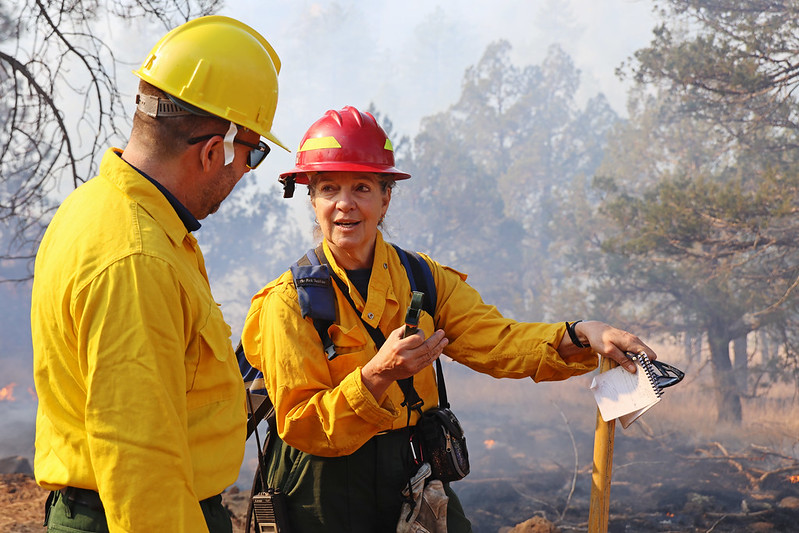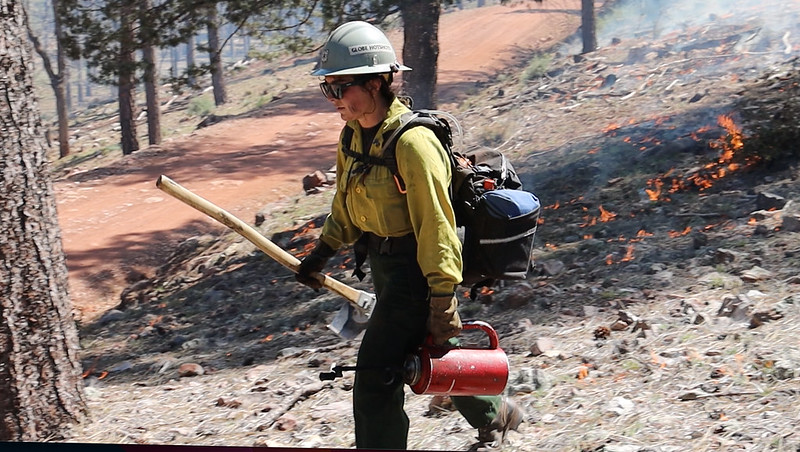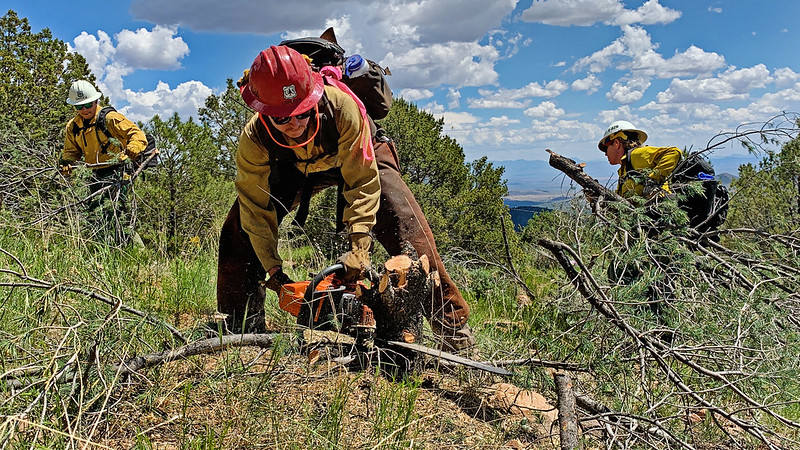Wildfire Crisis on the Tonto National Forest
Confronting the Wildfire Crisis
The USDA Forest Service launched a 10-year Wildfire Crisis Strategy to address the places where wildfire poses the most immediate threats to communities.
In January 2022, Agriculture Secretary Tom Vilsack and Forest Service Chief Randy Moore announced a comprehensive response to the nation’s growing wildfire crisis – “Confronting the Wildfire Crisis: A Strategy for Protecting Communities and Improving Resilience in America’s Forests.” The strategy outlines the need to significantly increase fuels and forest health treatments to address the escalating crisis of wildfire danger that threatens millions of acres and numerous communities across the United States.
In April 2022, the Forest Service identified the Tonto as one of four national forests that will treat approximately 47 percent of the Four Forest Restoration Initiative’s 2.4 million acres. Commonly known as 4FRI, it was one of the Forest Service’s 10 initial landscapes chosen for Bipartisan Infrastructure Law investment.
With additional funding under the Inflation Reduction Act, the Forest Service added 11 additional landscapes in early 2023. The agency again identified the Tonto as one of three national forests that will treat 3 million acres as part of the San Carlos Apache Tribal Forest Protection.
4FRI Landscape Investment
4FRI is a landscape-level effort to restore the structure, pattern, composition, and health of fire-adapted ponderosa pine ecosystems across 2.4 million acres in northern Arizona. The Tonto is actively restoring a landscape that encompasses six out of the top 10 highest-risk firesheds in the Southwestern Region. Furthermore, within the 4FRI footprint, nine out of the 10 high-risk fire areas in Arizona are being addressed.

Forest Service personnel, partners, volunteers, and contractors will use a full suite of restoration approaches to restore the landscape. Treatments will include mastication, biomass removal, timber harvesting, hand thinning and prescribed fire. Collectively these treatments will:
- Restore forest ecosystems
- Reduce threats of destructive wildfire to thriving forest communities
- Support sustainable forest industries that strengthen local economies
- Protect critical watersheds
- Conserve natural resources
The Forest Service consults with 17 Native American Tribes as well as 10 Navajo Nation chapters on 4FRI. The Forest Service is partnering with federal, state and local agencies to implement the Wildfire Crisis Strategy in the 4FRI landscape.
- Apache-Sitgreaves, Coconino & Kaibab National Forests
- Arizona Commerce Authority
- Arizona Department of Forestry and Fire Management
- Arizona Game and Fish Department
- Bureau of Reclamation
- Campbell Global
- County representatives from all 4FRI counties
- Ecological Restoration Institute
- Great Old Broads of Wilderness
- National Forest Foundation
- National Wild Turkey Federation
- NewLife Forest Products LLC
- Northern Arizona Loggers Association
- Novo BioPower
- Salt River Project
- The Center for Biological Diversity
- The Grand Canyon Trust
- The Nature Conservancy
- Trout Unlimited
Confronting the Wildfire Crisis: Second phase of Dude Fire restoration project improves forest health, protects watersheds
June 10, 2024
State-of-the-art helibase opens on Payson Ranger District
April 17, 2024
Payson Ranger District plans to burn over 5,000 acres near Diamond Rim to improve forest health, reduce risk of wildfire
April 15, 2024
Tonto fire officials plan hazardous fuels reduction project to improve watersheds in Christopher, Tonto and Cherry Creeks
Jan. 15, 2024
Hazardous fuels reduction continues with prescribed fires on Payson Ranger District
Nov. 24, 2023
Tonto National Forest schedules prescribed fire on Payson Ranger District to reduce hazardous fuels
Nov. 2, 2023
Fuel treatments planned on Payson Ranger District
June 30, 2023
Payson Ranger District prepares for prescribed fire operations
Dec. 1, 2022
Collaborative forest health improvement projects begin on Payson Ranger District
Sept. 30, 2022
Secretary Vilsack Announces New 10 Year Strategy to Confront the Wildfire Crisis
Jan. 18, 2022
San Carlos Apache Tribal Forest Protection Landscape Investment

This landscape includes National Forest System lands and San Carlos Reservation lands. For cross-boundary landscape restoration, the Forest Service is working with the San Carlos Apache Tribe to build on the two Tribal Forest Protection Act projects they initiated. '
Work on the landscape will protect international waters shared with the Tribe, associated drinking water systems, and residential areas. Fuels reduction work will reduce wildfire exposure to the Mount Graham International Observatory and two telecommunications sites, which include primary communications systems for local law enforcement.
Working cooperatively with the San Carlos Apache Tribe and various partners, the Tonto is using contracts and other partnership agreements to enable hiring and training of San Carlos fire crews as well as on-the-ground fuels treatments and surveys.
Work on this landscape will reduce wildfire exposure to communities within the San Carlos and Fort Apache Reservations. Landscape treatments will reintroduce wildland fire into fire-adapted ecosystems in a culturally sensitive way while emphasizing sustainable uses of cultural forest products, including clean water, traditional medicinal plant cover, firewood, and culturally significant food sources such as acorns, berries, and wildlife. Work will also foster public understanding and sharing of culturally significant information to better guide our land management decisions.

Along with the Apache-Sitgreaves and Coronado National Forests, the Tonto’s partners for the San Carlos Apache Tribal Forest Protection include:
- Arizona Department of Forestry and Fire Management
- Arizona Game and Fish Department
- Mule Deer Foundation
- National Forest Foundation
- Salt River Project
- San Carlos Apache Tribe
Mule Deer Foundation keystone agreement continues restoration of wildlife habitat on the Globe Ranger District
June 24, 2024
Tonto National Forest schedules prescribed fires on Globe Ranger District to reduce hazardous fuels
Oct. 18, 2023
Globe Ranger District prepares for prescribed burn
Nov. 10, 2022
Tonto officials authorize collaborative forest health improvement project
Jan. 13, 2022
Images and Videos
For additional photos and videos that can be downloaded visit the Tonto’s Flickr site.
Alerts & Warnings
- EVACUATIONS: 136th Street to 144th Street to Dove Valley Rd to Tonto Boundary
- NEVER Bring or Use Fireworks on Federal Lands. It is Illegal.
- 03-12-01-24-29 Riverside Fire Closure Order
- 03-12-03-24-26 Adams Fire Emergency Closure Revision
- 03-12-06-24-27 Tonto Creek Crossing Road Closures
- 03-12-00-24-24 Emergency Stage 1 Fire Restrictions Entire Forest
- 03-12-01-22-26 Rattlesnake Cove Recreation Fishing Dock Closure
- 03-12-01-24-28 Wildcat Safety Recovery Closure Order
- Amended - Apache Lake Closure - Lower Burnt Corral Campground remains closed
- Bald Eagle Seasonal Closures
- Occupancy and Use Restrictions
- Update on State Route 88 (Apache Trail) - August 18, 2021
- Redmond Fire Road Closure






